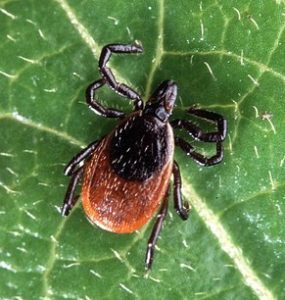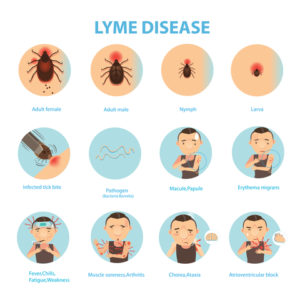Until two years ago, I never found a tick in my yard. Now with Buffy being blind, she mostly stays on the grass and hardly walks into the shrubby areas, so I was shocked when I saw a tick on her. I found another one on me after I had walked her around my residential neighborhood. Maybe I had brushed against some shrubs near the sidewalk. But these areas never had ticks before. What gives?
I work as an environmental consultant and often am outside in natural areas, so I’m very used to checking for ticks after being out in the woods—but ticks in my yard? I live in a residential area in a small city. I have an extra lot, with a mowed lawn, trees, native plants and ground covers. Yeah, there’s probably some mice and the occasional raccoon or opossum, but my yard has a fence, so I don’t get too many wild critters.
Last week, I heard a lecture on how ticks and tick-borne illness are spreading rapidly due to climate change. Lyme disease, which was non-existent in my county, has become common in the last few years. One health department employee said that he expects cases of Lyme disease to rise significantly.
Maybe I should think about retiring before I get sick. Should I risk it a few more years?
Dogs are exposed a lot more than we are since they walk in tall grasses and brush up against shrubs all the time. But there are tick preventatives for dogs. What about for us?
If we stay to the middle of the gravel trail, we’re safe right? Wrong. Ticks crawl around a lot and often will crawl off your dog onto you. Or they can fall out of trees onto you, or when you brush against the shrubs or step on the grass to pick up your dog’s poop.
Ask around. How many people do you know who have had, or know someone who has Lyme disease? I know several people from work. It’s becoming much more common.
What is Lyme disease and why should I be worried about it?
Lyme disease is caused by the bacterium Borrelia burgdorferi and is transmitted to people through deer ticks.

- Ticks take 24 to 36 hours to spread the bacteria to your blood. Remove them early.
- Most tick bites do not lead to Lyme disease (Medline Plus)
- Deer tick nymphs can be the size of a pinhead and almost impossible to see.
Symptoms may occur a week or many weeks later can include fever, headache, fatigue, and a characteristic skin rash called erythema migrans (the bullseye rash). Many symptoms resemble the flu, so most people don’t get tested for Lyme disease unless they tell their doctor about a tick bite or have the skin rash. Not everyone gets the skin rash.
Sometimes the only symptoms occur many months later as listed by the Center for Disease Control:
- Severe headaches and neck stiffness
- Additional EM rashes on other areas of the body
- Arthritis with severe joint pain and swelling, particularly the knees and other large joints.
- Facial palsy (loss of muscle tone or droop on one or both sides of the face)
- Intermittent pain in tendons, muscles, joints, and bones
- Heart palpitations or an irregular heartbeat
- Episodes of dizziness or shortness of breath
- Inflammation of the brain and spinal cord
- Nerve pain
- Shooting pains, numbness, or tingling in the hands or feet
- Problems with short-term memory
Early treatment with antibiotics is the best method to treat Lyme disease. But because the symptoms are often vague and sometimes long delayed, doctors often don’t test for Lyme disease or people don’t seek timely treatment.
If you were exposed to the bacteria, it will remain in your system even if you are asymptomatic. This can make diagnosing and treating the disease a challenge.

Ticks and Climate Change
Lyme disease cases have more than doubled since the 1990s. Most of the cases for Lyme disease occur in fourteen states in the Northeast, upper Midwest, and mid-Atlantic. The number of counties listed at high-risk for Lyme disease has since increased by 320%.
Lyme disease now occurs in the southeastern states. Climate change and our current governmental policies will likely allow this disease to expand.
It’s predicted that by 2050, 12% of the U.S. population may be infected by Lyme disease. Many of these cases will be chronic and this is likely to cause a huge healthcare financial burden–$4.8 – 9.6 billion in 2018 in the U.S—even higher in Europe.
How climate change is affecting deer ticks
- Temperature affects where deer ticks live. Longer lasting warm seasons cause ticks to be active for longer periods and they can survive farther north.
- Warmer temperatures shorten the time to maturity for ticks. One study showed that tick reproduction can increase by a factor of two in the US and by a factor of five in Canada.
- Higher humidity caused by increasing greenhouse gases is affecting deer ticks. Deer ticks may survive longer under highly humid conditions (85 – 95%).
- Mice that carry Lyme disease feed on acorns. Acorns periodically have bumper crops, and when that happens, there are more white-footed mice. More infected ticks were found for up to two years after a year of plentiful acorns
Other factors:
Removing farmlands and re-foresting areas allows ticks to flourish. Ticks survive where deer populations thrive since deer are important hosts for the bacteria. Deer populations are exploding in many areas due to the lack of predators.
Leaf litter prevents ticks from dehydrating. Forests have lots of leaf litter which also increases the tick population. Now that I know this, I should clear out my leaves in my shrub beds a lot sooner and better!
What can you do?
Staying indoors is not a realistic option for most of us, and still, we can get ticks that climb off our dogs and onto us. When I camp, my dog sleeps in my tent next to me and often ticks crawl on me in the middle of the night.
Typical recommendations include being cautious when you walk in tall grass or forested areas by doing the following:
- Roll your socks up over your pants so ticks will stay on your pants and you can find them.
- Wear light-colored clothes so you can see ticks.
- Spray yourself with insect repellant (although I haven’t found this to work so well with ticks).
- Wear a hat so ticks don’t get in your hair.
- When you come inside from tick-infested areas, put your clothes in the dryer for about 10 minutes on high—this will dry out the ticks and kill them. It’s even better than washing your clothes.
- Take a shower within a few hours of being inside.
- Use a washcloth when showering so you can scrub off any ticks—especially the ones you can’t see.
- If you find one embedded in your skin, use tweezers to remove it promptly. Keep the tick in a baggie and freeze it. You may need it to have your doctor test it for the bacteria if you develop symptoms.
For more information, I used this article for a lot of my information http://www.climatecentral.org/gallery/graphics/climate-changes-role-in-tick-migration
I also plan to read this book: Lyme: The First Epidemic of Climate Change. This review made it sound really good.
Next week I’ll talk about some of the controversies over using pesticides for ticks and Lyme vaccines for your dog.


This is a great, very comprehensive article! Thank you! I can’t stand ticks. One summer we boarded Sulley while we went on vacation. When he came home I noticed a couple ticks on him for the first time since moving to AZ. For the next month, every time he would go out to pee, he would come in with a few more. I had him treated with a topical medication, but it didn’t seem to do anything. It wasn’t until I gave him an oral AND a topical AND sprayed our yard, that we got rid of the ticks. It was awful! I’m sure the ticks were spread from Sulley being boarded and because we have so many shrubs and bushes, the ticks were happy and flourishing here. Thankfully, I have not seen one tick since that summer and it’s been 2 years.
Wow, I didn’t know Arizona had so many ticks since it is so dry. You really had to be diligent yo get rid of them
I hate ticks. With a passion. Sadly my yard is tick heaven. I just stay inside (but I don’t have a dog to take around like your Buffy.)
Ticks are really prevalent in our area. When my son was 13 he had an engorged tick and tested positive for Lyme Disease. He took antibiotics right away, but I’m still concerned it will be a problem for him down the road.
Lyme disease is so scary and moreso because it is so prevalent now. Another trick is to use a sticky roller on yourself and your dogs when you come inside. Also, try sprinkling diatomaceous earth and spread beneficial nematodes in your yard. These will help reduce the # of ticks in your yard and Buffy’s exposure to them when she is out there.
Reading this gives me the shivers! I don’t think I’ve ever had a tick on me (knock on wood). I live in the deep South, and we have much warmer months during the year, so I know we do have ticks.
Thanks for all the helpful tips. I think I’ll just stay inside, in bed, under the covers.
Seriously, I know a few people who contracted Lyme disease. It seemed to take years before they got a correct diagnosis. You want to avoid it at all costs.
Wow. I know so much my more about ticks. Probably stuff I should have known! It’s really interesting that re-foresting is a factor in their expansion. Kind of a good news bad news situation.
I so hate these things. When, finally, some scientists start working on a way to eradicate these things instead of inventing new chemicals for ourselves and our dogs?
Climate change has such an effect on so many things – people don’t realize the seriousness of it. Ticks really gross me out, but it’s such an important topic that bloggers need to spread the word about. I’m going to speak to my vet about protection for my indoor only cats.
My brother and my mother in law both have Lyme Disease. It’s scary stuff, especially if not caught right away. We always check the dogs and each other for ticks after we hike. They’re rampant down here!
What an interesting post and have learnt so much from it. I live in San Francisco and have never seen a tick on Layla from the park but do keep an eye out all the time. Thanks for sharing and opening my eyes to all this
Yikes!! To be honest I’ve never thought about ticks much, haven’t had to! For years I had indoor cats, then when I started bringing home dogs I never had an issue then either…until a couple of years ago I think it was. One of my neighbour’s was petting Jack and noticed a big tick on the top of his head! His fur was quite long and I never noticed it, nor did my husband. I was grossed out to be honest, thankfully he had a tick remover and took it out for me. I was particularly unhappy because his Soresto collar is supposed to protect against them. We have this wilderness as we call it right near where we live and Jack loves to run around there, and we’ve seen deer so it makes sense. Luckily it was only that one time, and since it’s been miserable weather here for so long I have no exposed skin. Definitely need to take your warnings seriously.
I hate hate HATE ticks! Yes, we have them, a boatload in Texas, with a number of tick-borne diseases affecting both pets and people. A friend of mine still has the aftermath of the disease to deal with, and this after more than a year of intensive hospitalization and treatment. Not something to mess with.
I never use to have to put a tick and flea collar on my little one when in the city until last year. CRAZY. I also use to only do a natural oil mix when going hiking. Those days are long gone. I have to use the collar … sucks. Monte can’t handle the protection that is topically placed on skin (drops) nor can his tummy handle the kind you ingest. So … collar it is.
Excellent topic and super well written!! I have a friend who was misdiagnosed with arthritis and was left to a walker until she finally got somebody to test for Lyme. We don’t get very good support medically here in Canada from what I’ve heard. I have heard various stories of those who have travelled to the US for treatment.
This is so timely, so thank you for a relevant and perceptive post. I read an article about Lyme Disease on the Humarian website a few days ago! There is definitely ‘something in the air’ about these nasty and dangerous little creatures with the upcoming European and American summer seasons.
I appreciate the list of tips for keeping them at bay, and I am beginning to realise just what a risk they are to dogs and people.
As for climate change YES! 100% This is one of the huge host of small and almost invisible changes that is transforming out planet and putting us at risk.
This is so scary but it is necessary to know and prevent. Lyme disease is horrible for animals and for use humans too. Thanks so much for the tips on how to prevent the ticks when camping or when enjoying the outdoors. Didn’t have a clue that ticks die when drying clothes inside the drier. This is a great advice.